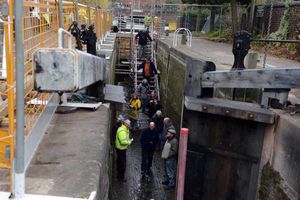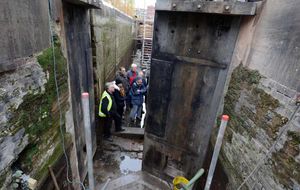Visitors get rare chance to walk along the bottom of Wolverhampton canal
Visitors were given the chance to see a rare view of a 200-year-old canal lock during a special open day in Wolverhampton.

The Wolverhampton Top Lock showed off its new lock gates with visitors able to walk along the original 200-year-old brickwork at the bottom of the 12ft drained lock.
The open day, on Saturday, was held by the Canal and River Trust and on the day visitors could also find out more about volunteering roles at the trust, from supporting wildlife projects to being a volunteer lock keeper, and learning about the history of the canals in the Midlands.

"To walk along the bed of a 200 year old lock, see the waterways' original 18th century design and understand the scale of the work we do to care for it, is a real privilege."
The works at the city centre Grade II listed structure are costing £55,000 in total and involve highly skilled craftsmanship.
The lock's bottom gates have been replaced after more than 20 years of service and the top gates are being refitted and relined to reduce water leakage. Minor brickwork repairs to the lock chamber are also being carried out.
At the start of the works a fabric dam held back nearly45 miles of water while the skilled team repaired the stop plank grooves in the lock chamber walls - the enable planks of wood to stay firmly in place to hold back the canal water.

Work started on November 9 and the lock gate is expected to be fully open again by December 11.
Richard Parry, chief executive of the Canal and River Trust, added: "We care for a remarkable network of historic waterways which are still working just as they were designed to 200 years ago. Keeping them open and safe requires a huge amount of planning, investment and craftsmanship and involves a wide range of experts, from civil engineers and hydrologists to heritage experts and ecologists."
The works are part of the Canal and River Trust's £4.2 million maintenance programme to canals and rivers across the West Midlands.
Richard Parry, chief executive of the trust, added: "We care for a remarkable network of historic waterways which are still working just as they were designed to 200 years ago. Keeping them open and safe requires a huge amount of planning, investment and craftsmanship and involves a wide range of experts, from civil engineers and hydrologists to heritage experts and ecologists."
The new gates, which were made at the Bradley lock gate workshop in Bilston, arrived at the lock by boat as gates would have done during the industrial revolution.
The two-ton gates have been replaced after being at the site for 25 years and are made using traditional methods.

The gates are hand-crafted using traditional methods in the trust's specialist workshops at Bradley and Stanley Ferry in Yorkshire.
A single lock gate can take up to 20 days to make and has a working life of between 25 and 30 years.
In order to be watertight, they need to be built very precisely, fitting tightly to the masonry of the lock walls and to each other.
The trust has also launched a three-month survey to uncover 'what lurks beneath' the canals here. The results will be announced in the spring.
Across the United Kingdom, hundreds of shopping trolleys, traffic cones, car tyres, bottles and plastic bags are hauled out of the canals by the trust and its volunteers at a cost of nearly £1m each year.
The trust, which is calling for an end to rubbish being dumped in its waterways, will be announcing the results in spring 2016.




